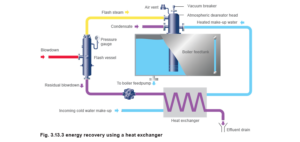In this article, I explain how heat recovery is done from the boiler blowdown and also share why the blowdown happens in a boiler.
You have to understand that the efficiency of the boiler is very significant when it comes to its operation.
If the boiler is not effective there will be no need for it to be installed for usage.
One of the factors that contribute to the efficiency of the boiler is to ensure that the boiler is clean.
If the boiler feedwater is not sufficiently cleaned then there is a possibility that an accumulation of contaminants in the boiler will occur.
If there is an accumulation of contaminants in the boiler, we won’t be able to remove the whole amount of water in the boiler.
The only thing we will have to do is to blow down the boiler.
This is the main reason why boiler blowdown is done;
Boiler blowdown is done to remove sediments, chemical contaminants, sludge and any solid contaminants in the boiler.
The blowdown of a boiler will leave the boiler with hot water together with the solid contaminants.
It’s impossible to prevent any amount of water from leaving the boiler during the blowdown.
This hot water leaving the boiler with the contaminants contains energy that we don’t want to waste.
And that is where the heat recovery blowdown of a boiler comes in.
Heat recovery blowdown of a boiler
The blowdown heat can be recovered using several ways that I am going to share with you.
The heat from the boiler blowdown can be recovered by either using a heat exchanger or a flash vessel.
It’s also possible to combine the flash tank with a heat exchanger to recover the heat from the boiler blowdown.
This is how the heat is recovered from the boiler blowdown using a heat exchanger and flash vessel;

The boiler blowdown is first directed to a flash vessel where the separation of flash steam and condensate mixed with the solid contaminants will happen.
You might like this: Flash Steam Recovery System: Definition, Function, Requirement, Advantages and Operation
The flash vessel separates the flash steam from the condensate, the flash steam is then taken to the deaerator, while the condensate with the solid contaminants flows out of the flash vessel via a heat exchanger.
It is in the heat exchanger where the heat is recovered and used again to heat the makeup water of the boiler.
While the solid contaminants from the boiler blow down with water that is cooled and flows out of the heat exchanger to the effluent drain.
One can also use the flash vessel only to recover the heat from the boiler blowdown, but the only downside is that the water leaving the boiler will still be hot.
And another thing to note is that it’s not that effective compared to using a flash vessel with a heat exchanger.
Final thoughts
Now you have an idea of how heat is recovered from the boiler blowdown. This process of recovering the heat is very important as it saves fuel and increases the thermal energy of the boiler since not much energy is lost.
The most effective way to recover heat from the boiler blowdown is to use the flash vessel in combination with the heat exchanger.
You get to recover enough heat from the boiler blowdown.
If you have any questions about this topic don’t be shy to leave your comment.
What I have shared is just a summary but there is a lot going on in the heat recovery of a boiler.
Anyway, thanks so much for reading the article. See you in my next article.
Related articles to check.

